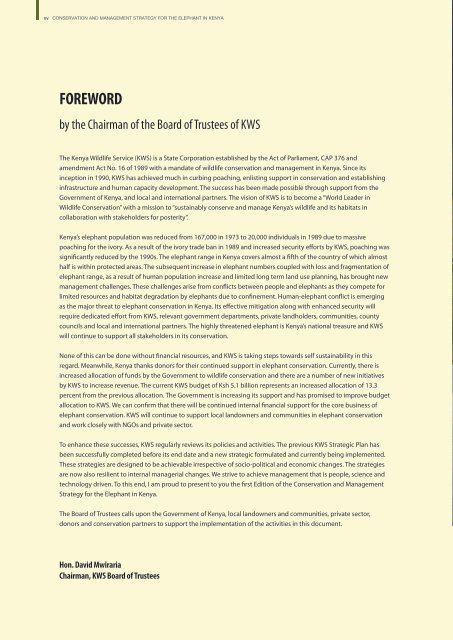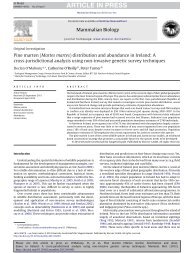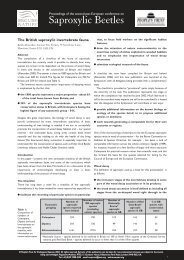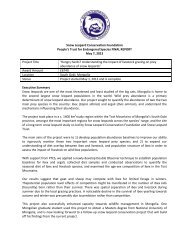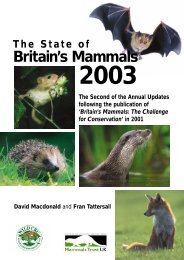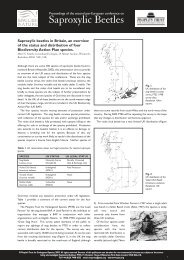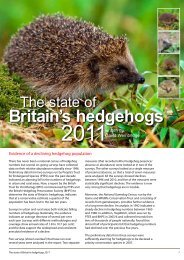National Elephant Strategy - People's Trust for Endangered Species
National Elephant Strategy - People's Trust for Endangered Species
National Elephant Strategy - People's Trust for Endangered Species
Create successful ePaper yourself
Turn your PDF publications into a flip-book with our unique Google optimized e-Paper software.
xv CONSERVATION AND MANAGEMENT STRATEGY FOR THE ELEPHANT IN KENYACONSERVATION AND MANAGEMENT STRATEGY FOR THE ELEPHANT IN KENYA xviFOREWORDby the Chairman of the Board of <strong>Trust</strong>ees of KWSThe Kenya Wildlife Service (KWS) is a State Corporation established by the Act of Parliament, CAP 376 andamendment Act No. 16 of 1989 with a mandate of wildlife conservation and management in Kenya. Since itsinception in 1990, KWS has achieved much in curbing poaching, enlisting support in conservation and establishinginfrastructure and human capacity development. The success has been made possible through support from theGovernment of Kenya, and local and international partners. The vision of KWS is to become a “World Leader inWildlife Conservation” with a mission to “sustainably conserve and manage Kenya’s wildlife and its habitats incollaboration with stakeholders <strong>for</strong> posterity”.Kenya’s elephant population was reduced from 167,000 in 1973 to 20,000 individuals in 1989 due to massivepoaching <strong>for</strong> the ivory. As a result of the ivory trade ban in 1989 and increased security ef<strong>for</strong>ts by KWS, poaching wassignificantly reduced by the 1990s. The elephant range in Kenya covers almost a fifth of the country of which almosthalf is within protected areas. The subsequent increase in elephant numbers coupled with loss and fragmentation ofelephant range, as a result of human population increase and limited long term land use planning, has brought newmanagement challenges. These challenges arise from conflicts between people and elephants as they compete <strong>for</strong>limited resources and habitat degradation by elephants due to confinement. Human-elephant conflict is emergingas the major threat to elephant conservation in Kenya. Its effective mitigation along with enhanced security willrequire dedicated ef<strong>for</strong>t from KWS, relevant government departments, private landholders, communities, countycouncils and local and international partners. The highly threatened elephant is Kenya’s national treasure and KWSwill continue to support all stakeholders in its conservation.None of this can be done without financial resources, and KWS is taking steps towards self sustainability in thisregard. Meanwhile, Kenya thanks donors <strong>for</strong> their continued support in elephant conservation. Currently, there isincreased allocation of funds by the Government to wildlife conservation and there are a number of new initiativesby KWS to increase revenue. The current KWS budget of Ksh 5.1 billion represents an increased allocation of 13.3percent from the previous allocation. The Government is increasing its support and has promised to improve budgetallocation to KWS. We can confirm that there will be continued internal financial support <strong>for</strong> the core business ofelephant conservation. KWS will continue to support local landowners and communities in elephant conservationand work closely with NGOs and private sector.“The highly threatened elephantis Kenya’s national treasure andKWS will continue to support allstakeholders in its conservation”To enhance these successes, KWS regularly reviews its policies and activities. The previous KWS Strategic Plan hasbeen successfully completed be<strong>for</strong>e its end date and a new strategic <strong>for</strong>mulated and currently being implemented.These strategies are designed to be achievable irrespective of socio-political and economic changes. The strategiesare now also resilient to internal managerial changes. We strive to achieve management that is people, science andtechnology driven. To this end, I am proud to present to you the first Edition of the Conservation and Management<strong>Strategy</strong> <strong>for</strong> the <strong>Elephant</strong> in Kenya.The Board of <strong>Trust</strong>ees calls upon the Government of Kenya, local landowners and communities, private sector,donors and conservation partners to support the implementation of the activities in this document.[ TOP ] Plate 12.Hon. David MwirariaChairman, KWS Board of <strong>Trust</strong>eesAdult male, Mara ecosystem.Renaud Fulconis - Awely, Wildlife and People


